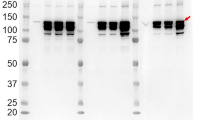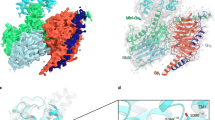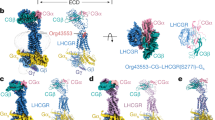Abstract
The atrial natriuretic peptide (ANP) hormone is secreted by the heart in response to an increase in blood pressure. ANP exhibits several potent anti-hypertensive actions in the kidney, adrenal gland and vascular system. These actions are induced by hormone binding extracellularly to the ANP receptor1, thereby activating its intracellular guanylyl cyclase domain for the production of cyclic GMP2. Here we present the crystal structure of the glycosylated dimerized hormone-binding domain of the ANP receptor at 2.0-Å resolution. The monomer comprises two interconnected subdomains, each encompassing a central β-sheet flanked by α-helices, and exhibits the type I periplasmic binding protein fold. Dimerization is mediated by the juxtaposition of four parallel helices, arranged two by two, which brings the two protruding carboxy termini into close relative proximity. From affinity labelling and mutagenesis studies, the ANP-binding site maps to the side of the dimer crevice and extends to near the dimer interface. A conserved chloride-binding site is located in the membrane distal domain, and we found that hormone binding is chloride dependent. These studies suggest mechanisms for hormone activation and the allostery of the ANP receptor.
This is a preview of subscription content, access via your institution
Access options
Subscribe to this journal
Receive 51 print issues and online access
$199.00 per year
only $3.90 per issue
Buy this article
- Purchase on Springer Link
- Instant access to full article PDF
Prices may be subject to local taxes which are calculated during checkout


Similar content being viewed by others
References
Chinkers, M. et al. A membrane form of guanylate cyclase is an atrial natriuretic peptide receptor. Nature 338, 78– 83 (1989).
Foster, D. C., Wedel, B. J., Robinson, S. W. & Garbers, D. L. Mechanisms of regulation and functions of guanylyl cyclases. Rev. Physiol. Biochem. Pharmacol. 135, 1– 39 (1999).
Wedel, B. J. & Garbers, D. L. New insights on the functions of the guanylyl cyclase receptors. FEBS Lett. 410, 29–33 (1997).
Misono, K. S., Sivasubramanian, N., Berkner, K. & Zhang, X. Expression and purification of the extracellular ligand-binding domain of the atrial natriuretic peptide (ANP) receptor: monovalent binding with ANP induces 2:2 complexes. Biochemistry 38, 516–523 (1999).
Miyagi, M. & Misono, K. S. Identification and characterization of glycosylation sites in the extracellular domain of the atrial natriuretic peptide receptor: Oligosaccharide structures are not required for hormone binding. Eur. J. Biochem. (submitted).
O'Hara, B. P. et al. Crystal structure and induction mechanism of AmiC-AmiR: a ligand-regulated transcription antitermination complex. EMBO J. 18, 5175–5186 ( 1999).
Saper, M. A. & Quiocho, F. A. Leucine, isoleucine, valine-binding protein from Escherichia coli. Structure at 3.0-Å resolution and location of the binding site. J. Biol. Chem. 258, 11057–11062 (1983).
Wilson, E. M. & Chinkers, M. Identification of sequences mediating guanylyl cyclase dimerization. Biochemistry 34, 4696–4701 (1995).
Lowe, D. G. Human natriuretic peptide receptor-A guanylyl cyclase is self-associated prior to hormone binding. Biochemistry 31, 10421 –10425 (1992).
Conte, L. L., Chothia, C. & Janin, J. The atomic structure of protein-protein recognition sites. J. Mol. Biol. 285, 2177– 2198 (1999).
Lawrence, M. C. & Colman, P. M. Shape complementarity at protein/protein interfaces. J. Mol. Biol. 234, 946–950 (1993).
Syed, R. S. et al. Efficiency of signalling through cytokine receptors depends critically on receptor orientation. Nature 395, 511–516 (1998).
Labrecque, J., McNicoll, N., Marquis, M., & De Léan, A. A disulphide-bridged mutant of natriuretic peptide receptor-A displays constitutive activity. J. Biol. Chem. 274, 9752– 9759 (1999).
Huo, X., Abe, T. & Misono, K. S. Ligand binding-dependent limited proteolysis of the atrial natriuretic peptide receptor: juxtamembrane hinge structure essential for transmembrane signal transduction. Biochemistry 38, 16941–16951 (1999).
McNicoll, N., Gagnon, J., Rondeau, J. -J., Ong, H. & De Léan, A. Localization by photoaffinity labeling of natriuretic peptide receptor-A binding domain. Biochemistry 35, 12950–12956 ( 1996).
Engel, A. M. & Lowe, D. G. Characterization of the hormone binding site of natriuretic peptide receptor-C. FEBS Lett. 360, 169–172 (1995).
Duda, T., Goraczniak, R. M. & Sharma, R. K. Site-directed mutational analysis of a membrane guanylate cyclase cDNA reveals the atrial natriuretic factor signaling site. Proc. Natl Acad. Sci. USA 88, 7882– 7886 (1991).
Itakura, M., Suzuki, H. & Hirose, S. Structural analysis of natriuretic peptide receptor-C by truncation and site-directed mutagenesis. Biochem. J. 322, 585–590 (1997).
Wada, A. et al. Identification of ligand recognition sites in heat-stable enterotoxin receptor, membrane-associated guanylyl cyclase C by site-directed mutational analysis. Inf. Immun. 64, 5144– 5150 (1996).
Katafuchi, T. et al. Modulation by NaCl of atrial natriuretic peptide receptor levels and cyclic GMP responsiveness to atrial natriuretic peptide of cultured vascular endothelial cells. J. Biol. Chem. 267, 7624–7629 (1992).
Veress, A. T., Honrath, U., Chong, C. K. & Sonnenberg, H. Renal resistance to ANF in salt-depleted rats is independent of sympathetic or ANG-aldosterone systems. Am. J. Physiol. 272, F545–F550 (1997).
Otwinowski, Z. & Minor, W. Processing of X-ray diffraction data collected in oscillation mode. Methods Enzymol. 276, 307–326 ( 1997).
Terwilliger, T. C. & Berendzen, J. Automated MAD and MIR structure solution. Acta Crystallogr. D 55, 849–861 (1999).
The CCP4 suite: Programs for computational crystallography. Acta Crystallogr. D 50, 760–763 (1994).
Jones, T. A., Zou, J. Y., Cowan, S. W. & Kjeldgaard, M. Improved methods for building protein models in electron density maps and the location of errors in these models. Acta Crystallogr. A 47, 110–119 (1991).
Brunger, A. T. et al. Crystallography & NMR system: A new software suite for macromolecular structure determination. Acta Crystallogr. D 54, 905–921 (1998).
Kraulis, P. J. MOLSCRIPT: A program to produce both detailed and schematic plots of protein structures. J. Appl. Crystal. 24, 946– 950 (1991).
Merritt, E. M. & Bacon, D. J. Raster3D: Photorealistic molecular graphics. Methods Enzymol. 277, 505–524 (1997).
Nicholls, A., Sharp, K. A., & Honig, B. Protein folding and association: insights from the interfacial and thermodynamic properties of hydrocarbons. Proteins Struct. Funct. Genet. 11, 281–296 (1991).
He, X., Nishio, K., & Misono, K. S. High-yield affinity alkylation of the atrial natriuretic factor receptor binding site. Bioconjug. Chem. 6, 541–548 (1995).
Misono, K. S. Atrial natriuretic factor binding to its receptor is dependent on chloride concentration: a possible feedback-control mechanism in renal salt regulation. Circ. Res. 86, 1135–1139 (2000).
Acknowledgements
This work was supported by grants from the NIH (K.S.M.) and the American Heart Association (K.S.M. and V.C.Y.) and by a NIH postdoctoral fellowship (F.v.d.A.). We thank G. Stark for his support. Diffraction data were measured at the Advanced Light Source and on the Structural Biology Center beamline at the Advanced Photon Source, supported by the US Department of Energy, and at the National Synchrotron Light Source, Brookhaven National Laboratory, supported by the U.S. Department of Energy and the National Institutes of Health. We are grateful to E. Walker and the CCF LRI Computer Core for facilities support, to S. Ginell and T. Earnest for beamline support, to L. Pearl for coordinates of the AmiC/AmiR structure, and to M. Young for interesting discussions. Purification and crystallization of the ANP receptor hormone-binding domain, ANP-binding site determination, binding studies and other functional characterizations were carried out by X.Z., M.M., X.H. and K.S.M. Data collection, structure determination and refinement, and structure analysis were carried out by F.v.d.A. and V.C.Y.
Author information
Authors and Affiliations
Corresponding author
Rights and permissions
About this article
Cite this article
van den Akker, F., Zhang, X., Miyagi, M. et al. Structure of the dimerized hormone-binding domain of a guanylyl- cyclase-coupled receptor. Nature 406, 101–104 (2000). https://doi.org/10.1038/35017602
Received:
Accepted:
Issue Date:
DOI: https://doi.org/10.1038/35017602
This article is cited by
-
Purification, characterization, and preliminary serial crystallography diffraction advances structure determination of full-length human particulate guanylyl cyclase A receptor
Scientific Reports (2022)
-
CO2/bicarbonate modulates cone photoreceptor ROS-GC1 and restores its CORD6-linked catalytic activity
Molecular and Cellular Biochemistry (2018)
-
Clathrin-dependent internalization, signaling, and metabolic processing of guanylyl cyclase/natriuretic peptide receptor-A
Molecular and Cellular Biochemistry (2018)
-
Natriuretic peptide receptor A as a novel target for cancer
World Journal of Surgical Oncology (2014)
-
Structural mechanism of ligand activation in human GABAB receptor
Nature (2013)
Comments
By submitting a comment you agree to abide by our Terms and Community Guidelines. If you find something abusive or that does not comply with our terms or guidelines please flag it as inappropriate.



